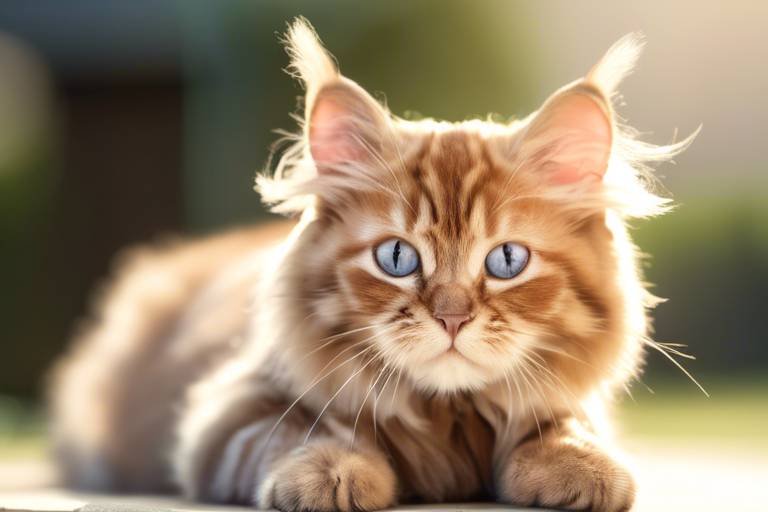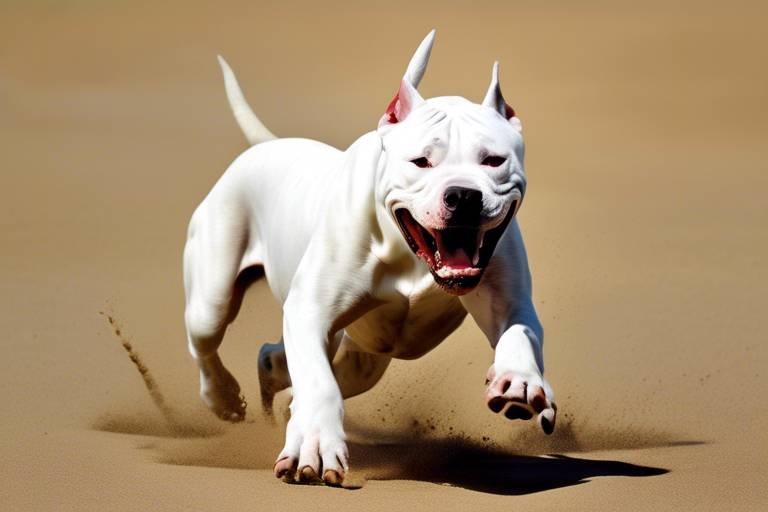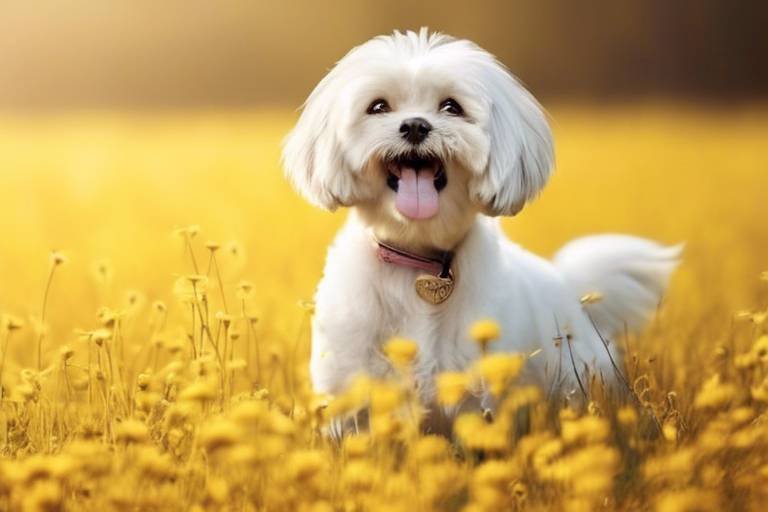The Gentle Nature of the American Staffordshire Terrier
The American Staffordshire Terrier, often affectionately called the AmStaff, is a breed that has garnered a reputation for its strength and loyalty. However, beneath that tough exterior lies a gentle giant that is often misunderstood. In this article, we will explore the temperament, training, and care requirements of these amazing dogs, shedding light on their loving nature and dispelling the myths that surround them. Are you ready to discover the true essence of the American Staffordshire Terrier?
The American Staffordshire Terrier has a rich history that dates back to the early 19th century. Originally bred for bull-baiting and later as farm dogs, their strong build and tenacity were highly valued. However, as society evolved, so did the purpose of these dogs. They transitioned from working dogs to beloved family pets. Today, the American Staffordshire Terrier is known for its gentle demeanor and affectionate nature, making them great companions for both individuals and families. Their origins as loyal and protective dogs have shaped their character, ensuring that they remain devoted to their human counterparts.
When it comes to temperament, the American Staffordshire Terrier is a blend of loyalty, affection, and protective instincts. These dogs are known for their unwavering loyalty to their families, often forming deep bonds that last a lifetime. They are affectionate and enjoy being around people, which makes them excellent family pets. Their protective nature means they will stand by their loved ones, making them natural guardians. It’s important to note that while they may appear intimidating, their hearts are filled with love and warmth.
The American Staffordshire Terrier’s affectionate nature truly shines in a family setting. They thrive on human interaction and are often referred to as “velcro dogs” due to their tendency to stick close to their owners. Whether it’s cuddling on the couch or playing in the yard, these dogs are happiest when they are with their human family. Their playful demeanor and love for children make them ideal companions, fostering deep emotional connections that enrich the lives of everyone involved.
Socialization is vital for any dog, but it's particularly important for the American Staffordshire Terrier. Early exposure to various environments, people, and other animals helps nurture a well-rounded dog. By introducing your AmStaff to different experiences, you ensure that they grow up to be confident and well-adjusted. This can lead to positive interactions with strangers and other pets, reducing the likelihood of fear-based aggression. Remember, a well-socialized dog is a happy dog!
While the American Staffordshire Terrier is generally gentle, like any breed, they can exhibit aggression if not properly trained or socialized. It’s essential to approach training with positive reinforcement techniques. Instead of punishment, rewarding good behavior encourages them to repeat those actions. Consistency is key; establishing a routine helps them understand expectations. Remember, patience and understanding go a long way in nurturing a loving and well-behaved companion.
Training an American Staffordshire Terrier can be a rewarding experience, especially given their intelligence and eagerness to please. Here are a few effective training techniques:
- Positive Reinforcement: Always reward your dog with treats, praise, or playtime when they follow commands.
- Short Sessions: Keep training sessions brief but frequent to maintain their attention.
- Consistency: Use the same commands and signals to avoid confusing your dog.
These techniques not only help in teaching commands but also strengthen the bond between you and your AmStaff, making training a fun and engaging experience.
Like any breed, American Staffordshire Terriers can face certain health issues. Common concerns include hip dysplasia, skin allergies, and heart problems. Regular veterinary check-ups are crucial for early detection and management of these issues. Additionally, keeping an eye on their weight is important, as obesity can lead to further health complications. By providing proper care and attention, you can help your AmStaff live a long, healthy life.
Nutrition plays a vital role in the overall health of your American Staffordshire Terrier. A balanced diet rich in proteins, fats, and essential nutrients is necessary to support their energy levels and maintain a healthy weight. Look for high-quality dog food that lists meat as the first ingredient. It’s also beneficial to consult with your veterinarian to determine the best diet plan tailored to your dog’s specific needs.
Exercise is essential for the American Staffordshire Terrier, as it helps maintain their physical fitness and mental stimulation. Regular walks, playtime in the yard, and interactive games are great ways to keep them active. Aim for at least an hour of exercise each day to ensure they stay healthy and happy. Remember, a tired dog is a well-behaved dog!
Despite their gentle nature, American Staffordshire Terriers are often victims of stereotypes and misconceptions. Many people view them as aggressive or dangerous, but this couldn't be further from the truth. It's essential to dispel these myths and promote a more accurate perception of the breed. With proper training, socialization, and love, these dogs can be some of the most loyal and affectionate companions one could ask for.
Q: Are American Staffordshire Terriers good with children?
A: Yes! They are known for being gentle and affectionate with children, making them great family pets.
Q: Do they require a lot of exercise?
A: Absolutely! Regular exercise is crucial to keep them healthy and happy.
Q: Are they aggressive?
A: No, aggression is typically a result of poor training or socialization. With proper care, they are loving companions.
Q: How do I train my American Staffordshire Terrier?
A: Use positive reinforcement techniques, keep training sessions short, and be consistent with commands.

Understanding the Breed
The American Staffordshire Terrier is a breed that often faces misconceptions and stereotypes, yet beneath that tough exterior lies a heart full of love and loyalty. To truly appreciate this breed, it's essential to delve into their history and characteristics. Originally bred in the 19th century for bull-baiting and as farm dogs, these canines have evolved significantly over the years. They were developed from a mix of bulldog and terrier breeds, which gave them their muscular build and tenacity. However, what many people fail to realize is that these traits have been channeled into a gentle and affectionate nature that makes them wonderful companions.
As we explore the origins of the American Staffordshire Terrier, it's fascinating to note how they transitioned from working dogs to beloved family pets. Their journey began in England, where they were utilized for various purposes, including as ratters and as companions for farmers. This breed has a strong history of being by the side of humans, which has fostered their inherent desire for companionship and loyalty. Today, they are often seen as loving and devoted pets, known for their playful spirit and gentle demeanor.
In terms of physical characteristics, the American Staffordshire Terrier boasts a strong, muscular frame with a broad head and powerful jaws. They typically weigh between 40 to 70 pounds and stand about 17 to 19 inches tall at the shoulder. Their short coat is easy to maintain and comes in a variety of colors and patterns. This breed's appearance can be intimidating, but it’s essential to look beyond the surface. The American Staffordshire Terrier is often described as a gentle giant, showcasing a personality that is far removed from the aggressive image that some may hold.
Moreover, their intelligence and eagerness to please make them highly trainable. When raised in a loving environment and provided with proper training, these dogs can exhibit remarkable behavior and loyalty. They thrive on human interaction and are known to form strong bonds with their families. This affectionate nature is one of the key reasons why they are often referred to as “nanny dogs,” as they are known to be exceptionally good with children and protective of their loved ones.
In summary, the American Staffordshire Terrier is a breed rich in history and character. Their journey from working dogs to loving family pets is a testament to their adaptability and loyalty. Understanding this breed's background and temperament is crucial in dispelling the myths that often surround them. By recognizing their gentle nature, we can appreciate the unique qualities that make the American Staffordshire Terrier a cherished companion.

Temperament Traits
The American Staffordshire Terrier, often affectionately referred to as the AmStaff, is a breed that embodies a unique blend of strength and gentleness. These dogs are not just muscular companions; they are known for their loyalty, affection, and protective instincts that make them remarkable family pets. Despite their tough appearance, AmStaffs have a heart of gold, often surprising those who take the time to get to know them. Their temperament is a delightful mix of playfulness and calmness, making them well-suited for various living situations, from bustling households to quieter homes.
One of the most striking traits of the American Staffordshire Terrier is their unwavering loyalty to their human companions. They thrive on companionship and are known to form deep bonds with their families. This loyalty is not just about being a loving pet; it’s about being a true member of the family. AmStaffs are often protective of their loved ones, which can sometimes be misconstrued as aggression. However, when properly trained and socialized, their protective nature becomes a comforting presence rather than a cause for concern.
Affection is another cornerstone of the American Staffordshire Terrier's temperament. These dogs are notorious for their love of cuddling and being close to their humans. They often seek out affection, whether it’s through gentle nudges with their nose or by curling up next to you on the couch. This affectionate demeanor makes them ideal companions for families, as they can easily adapt to both children and adults alike. In fact, many AmStaffs are known to be incredibly gentle with children, showcasing their nurturing side.
When it comes to companionship, the American Staffordshire Terrier truly shines. Their affectionate nature fosters deep emotional connections with their human counterparts. It’s not uncommon to see an AmStaff following their owner from room to room, always eager to be part of the action. This desire to be close can sometimes lead to separation anxiety if they are left alone for extended periods. Therefore, it's essential to ensure they have plenty of social interaction and mental stimulation to keep them happy and secure.
Socialization plays a crucial role in nurturing a well-rounded American Staffordshire Terrier. Early exposure to a variety of people, environments, and other animals helps them develop into confident and friendly dogs. This process is vital in ensuring that they interact positively with everyone they meet. A well-socialized AmStaff is less likely to exhibit fear-based behaviors, which can lead to misunderstandings about their temperament. It's important to remember that socialization is an ongoing process; regular outings and interactions should continue throughout their lives.
While American Staffordshire Terriers are generally gentle and loving, some may exhibit aggressive tendencies if not properly trained. It’s essential to address any signs of aggression early on to prevent it from becoming a serious issue. Positive reinforcement training methods, such as rewarding good behavior with treats or praise, can be extremely effective in managing aggression. Consistency is key; training should be a regular part of their routine to reinforce desirable behaviors. Additionally, providing them with ample exercise and mental stimulation can help reduce pent-up energy that might otherwise manifest as aggression.
Training an American Staffordshire Terrier can be a rewarding experience, thanks to their intelligence and eagerness to please. They thrive on positive reinforcement, so using treats, praise, and playtime as rewards can lead to successful training sessions. It's beneficial to start training at a young age, as puppies are particularly receptive to learning new commands and behaviors. Incorporating fun activities, such as agility training or obedience classes, can enhance their skills while strengthening the bond between you and your AmStaff.
In conclusion, the temperament traits of the American Staffordshire Terrier reveal a breed that is much more than its muscular build. With their loyalty, affection, and protective instincts, they make wonderful companions for families and individuals alike. Understanding these traits can help potential owners appreciate the true nature of this breed, dispelling common misconceptions and highlighting the gentle giants that they are.
- Are American Staffordshire Terriers good with children? Yes, they are known for their gentle nature and can be very affectionate with children when properly socialized.
- Do they require a lot of exercise? Yes, American Staffordshire Terriers need regular exercise to maintain their physical health and mental stimulation.
- How can I manage my AmStaff's aggression? Positive reinforcement training, socialization, and consistent routines are key to managing aggression.
- What is the best diet for an American Staffordshire Terrier? A balanced diet that meets their nutritional needs is essential; consult with a veterinarian for specific recommendations.
Affectionate Companions
When it comes to finding a loyal friend, the American Staffordshire Terrier stands out as an exceptional choice. These dogs are not just pets; they are family members who thrive on companionship and affection. Imagine coming home after a long day, and there they are, wagging their tails, eyes sparkling with joy, ready to shower you with love. It's a heartwarming sight that can melt away the stress of the day in an instant.
One of the most remarkable aspects of the American Staffordshire Terrier is their ability to form deep emotional bonds with their human companions. They possess an innate sense of loyalty that makes them protective yet gentle. This breed is known for its playful and affectionate nature, often seen cuddling up on the couch or playfully engaging in games with children. Their love knows no bounds, and they have a unique way of making every family member feel special.
Furthermore, their affectionate demeanor is not limited to just humans; they also tend to get along well with other pets. With proper socialization, an American Staffordshire Terrier can become a loving friend to cats, rabbits, and even other dogs. This adaptability makes them a wonderful addition to any household. However, it’s essential to understand that socialization should start early to nurture their friendly nature.
To give you a clearer picture of their affectionate characteristics, here’s a quick overview:
| Characteristic | Description |
|---|---|
| Loyalty | They are fiercely loyal to their families, often forming strong attachments. |
| Affectionate | They love to cuddle and show affection through physical touch. |
| Playful | They enjoy playtime and are known for their fun-loving nature. |
| Protective | They have a natural instinct to protect their loved ones. |
In essence, American Staffordshire Terriers are more than just pets; they are who bring joy, love, and a sense of security to their homes. Their ability to connect with people on an emotional level is truly remarkable. If you’re looking for a furry friend who will stand by your side, shower you with love, and make every day brighter, this breed might just be the perfect match for you.
As with any breed, it’s essential to remember that individual personalities can vary. While the majority of American Staffordshire Terriers are known for their loving nature, each dog is unique and may have different socialization needs. So, are you ready to welcome an affectionate companion into your life?
- Are American Staffordshire Terriers good with children? Yes, they are generally very good with children and can be playful and protective.
- Do they require a lot of exercise? Yes, regular exercise is essential for their physical and mental well-being.
- How can I ensure my American Staffordshire Terrier is well-socialized? Start socialization early and expose them to different environments, people, and pets.
- Are they aggressive dogs? With proper training and socialization, they can be gentle and loving companions.
Socialization Importance
When it comes to raising a well-rounded American Staffordshire Terrier, socialization plays a crucial role. Think of socialization as the foundation of a house; without it, the structure can become unstable. From a young age, exposing your AmStaff to various environments, people, and other animals is essential for their development. This breed is known for its loyalty and protective instincts, but these traits can sometimes lead to misunderstandings if they are not properly socialized.
Imagine a world where your American Staffordshire Terrier feels comfortable and confident in any situation. By introducing them to different experiences, such as meeting new people, visiting parks, or interacting with other pets, you are helping them develop a positive attitude toward the world around them. Socialization should start early—ideally, during the critical developmental stages of 3 to 14 weeks—but it’s never too late to begin. Adult dogs can also benefit from socialization, which can help reduce anxiety and fear in unfamiliar situations.
Moreover, socialization helps mitigate behavioral issues that can arise from fear or aggression. An American Staffordshire Terrier that has been well-socialized is less likely to react defensively in new situations, making them a more enjoyable companion. To ensure effective socialization, consider the following:
- Expose your dog to a variety of environments—busy streets, quiet parks, pet-friendly stores.
- Encourage positive interactions with people of all ages and other animals.
- Enroll in puppy classes or obedience training to facilitate socialization in a controlled environment.
Remember that socialization is not a one-time event; rather, it’s an ongoing process that should continue throughout your dog’s life. Regularly introducing your American Staffordshire Terrier to new experiences will help keep their social skills sharp and their temperament balanced. Ultimately, a well-socialized AmStaff is a happy, confident dog that thrives in any setting, ensuring they can be the loving family member you know they can be.
Q: At what age should I start socializing my American Staffordshire Terrier?
A: It's best to start socializing your AmStaff between 3 to 14 weeks of age, but you can continue to socialize them at any age.
Q: How can I tell if my dog is well-socialized?
A: A well-socialized dog is typically comfortable around new people and pets, shows curiosity rather than fear, and exhibits calm behavior in unfamiliar environments.
Q: What if my dog shows signs of aggression towards other dogs?
A: If your dog displays aggression, it's important to consult with a professional trainer or behaviorist who can help you address these issues through positive reinforcement and structured socialization.
Handling Aggression
When it comes to the American Staffordshire Terrier, many people are quick to jump to conclusions about their temperament, often associating them with aggression. However, understanding how to handle and manage any signs of aggression is crucial for a harmonious relationship with this breed. The key lies in recognizing that aggression is not an inherent trait of the American Staffordshire Terrier; rather, it can stem from fear, lack of socialization, or improper training. Addressing these factors early on can help mitigate aggressive behaviors.
One of the most effective ways to handle aggression in American Staffordshire Terriers is through positive reinforcement training. This method focuses on rewarding good behavior rather than punishing undesirable actions. For instance, when your dog exhibits calm behavior around other dogs or people, offering treats or praise can reinforce that behavior, encouraging them to repeat it. Think of it like teaching a child: rewarding good actions fosters a positive environment where they feel safe and loved, thus reducing the likelihood of aggressive outbursts.
Additionally, consistent training is essential. Establishing clear rules and boundaries helps your American Staffordshire Terrier understand what is expected of them. This consistency creates a sense of security, allowing them to thrive. Consider incorporating commands such as "sit," "stay," and "leave it" into your training sessions. These commands not only enhance obedience but also serve as tools for redirecting potentially aggressive behavior. For example, if your dog begins to show signs of aggression, commanding them to "sit" can help refocus their attention and calm them down.
Socialization plays a critical role in managing aggression as well. Exposing your American Staffordshire Terrier to various environments, people, and other pets from an early age can significantly reduce fear-based aggression. Gradually introducing them to new experiences helps them build confidence and learn appropriate behavior in different situations. Remember, the more positive interactions they have, the less likely they are to react aggressively out of fear or uncertainty.
Lastly, if you find that your American Staffordshire Terrier exhibits persistent aggressive behavior, it may be beneficial to consult a professional dog trainer or behaviorist. These experts can provide tailored guidance and techniques that cater to your dog's specific needs. Just like a coach helps an athlete improve their skills, a professional can help you and your dog navigate challenges and develop a stronger bond.
In summary, handling aggression in American Staffordshire Terriers requires a combination of positive reinforcement, consistent training, and socialization. By focusing on these strategies, you can help your dog become a well-adjusted, loving companion, proving that their gentle nature is just beneath the surface, waiting to shine.
- What are the signs of aggression in American Staffordshire Terriers? Signs can include growling, baring teeth, lunging, or stiff body posture. It's essential to observe your dog's behavior closely.
- How can I tell if my dog is feeling anxious or fearful? Look for signs such as excessive barking, pacing, hiding, or tucking their tail. Understanding these signals can help you address their needs.
- Is it safe to have an American Staffordshire Terrier around children? Yes, with proper training and socialization, they can be excellent companions for children, often being very affectionate and protective.
- What should I do if my dog shows aggression towards other dogs? Seek help from a professional trainer to develop a behavior modification plan tailored to your dog's needs.
Training Techniques
When it comes to training an American Staffordshire Terrier, the approach you take can make all the difference. These dogs are not only intelligent but also incredibly eager to please their owners. This unique combination means that with the right techniques, you can turn your AmStaff into a well-behaved companion that excels in obedience and social interactions. But what does effective training look like? Let's dive into some practical methods that can help you achieve the best results.
First and foremost, positive reinforcement is the cornerstone of training for American Staffordshire Terriers. This technique involves rewarding your dog for good behavior rather than punishing them for mistakes. Think of it like this: when you praise or treat your dog for sitting on command, you're essentially saying, "Yes! This is what I want!" Over time, your dog will associate the action with the reward, making them more likely to repeat it. This method not only builds a trusting relationship but also makes training sessions enjoyable for both you and your furry friend.
Another effective technique is to keep training sessions short and engaging. AmStaffs, while intelligent, can become bored easily. Aim for sessions that last about 5 to 10 minutes, filled with fun activities and challenges. You can incorporate games like fetch or hide-and-seek to reinforce commands while keeping your dog mentally stimulated. For instance, you might hide treats around the house and encourage your dog to find them, which reinforces their sense of smell and problem-solving skills.
Consistency is also key in training your American Staffordshire Terrier. Establishing a routine helps your dog understand what is expected of them. For example, if you want your dog to sit before being fed, make sure you always require this behavior before mealtime. This consistency helps your dog learn and adapt quickly. It’s also beneficial to use the same commands and cues every time. If one day you say "Sit" and the next day you say "Down," it can confuse your dog. Stick to a set of commands to ensure clarity.
Socialization is another critical aspect of training. Exposing your American Staffordshire Terrier to different environments, people, and other animals is vital for their development. Early socialization helps prevent behavioral issues down the line. Consider enrolling your dog in puppy classes or arranging playdates with other dogs. This exposure teaches them how to interact appropriately and builds their confidence. Remember, a well-socialized dog is a happy dog!
Lastly, don't underestimate the power of patience. Training takes time, and every dog learns at their own pace. There will be moments of frustration, but it’s essential to stay calm and supportive. If your AmStaff struggles with a command, take a step back and try again later. Celebrate the small victories, and always end training sessions on a positive note. This approach not only reinforces good behavior but also strengthens your bond with your dog.
In summary, training an American Staffordshire Terrier can be a rewarding experience. By using positive reinforcement, keeping sessions short and engaging, maintaining consistency, prioritizing socialization, and exercising patience, you can cultivate a well-mannered and loving companion. Remember, the journey of training is not just about commands; it’s about building a lifelong relationship with your furry friend.
- What is the best age to start training my American Staffordshire Terrier?
It’s best to start training as early as possible, ideally when they are still puppies, around 8 weeks old. Early training and socialization help shape their behavior. - How long should training sessions be?
Training sessions should be kept short, around 5 to 10 minutes, to keep your dog engaged and prevent boredom. - What are some common commands I should teach?
Basic commands like "Sit," "Stay," "Come," and "Down" are essential for a well-behaved dog. - Can I train my American Staffordshire Terrier on my own?
Yes, many owners successfully train their dogs at home. However, consider seeking professional help if you encounter challenges.

Health Considerations
The health of your American Staffordshire Terrier is paramount to ensuring they live a long, happy life. Like any breed, they are prone to specific health issues that every owner should be aware of. Being informed about these potential health concerns allows you to take proactive measures in maintaining your furry friend's well-being. It's essential to have regular check-ups with a veterinarian who understands the breed and can spot any early signs of health issues. Some common health problems seen in American Staffordshire Terriers include hip dysplasia, skin allergies, and heart disease. By being vigilant and attentive, you can help your dog live a healthier life.
One of the best ways to keep your American Staffordshire Terrier in tip-top shape is through proper nutrition. A well-balanced diet tailored to their specific needs can make a world of difference. Make sure to choose high-quality dog food that lists meat as the first ingredient and contains essential vitamins and minerals. Remember, just like us, dogs require a variety of nutrients to thrive, so a diet rich in protein, healthy fats, and carbohydrates is crucial. Here’s a quick overview of what to look for in their diet:
| Nutrient | Importance |
|---|---|
| Protein | Supports muscle development and overall health. |
| Fats | Provides energy and promotes healthy skin and coat. |
| Carbohydrates | Offers energy and aids in digestion. |
| Vitamins and Minerals | Boosts immune function and overall well-being. |
In addition to nutrition, regular exercise is another cornerstone of good health for American Staffordshire Terriers. These dogs are energetic and require daily physical activity to keep them fit and mentally stimulated. A lack of exercise can lead to obesity and behavioral issues, so aim for at least an hour of exercise each day. Activities like walking, running, and playing fetch not only keep them physically active but also strengthen the bond between you and your pet. Think of exercise as a way to unleash their inner puppy, helping them to thrive both physically and mentally.
Lastly, always keep an eye on your dog’s weight. Obesity can lead to a myriad of health problems, including joint issues and diabetes. Regular weigh-ins can help you keep track of their health. If you notice any sudden weight changes, consult your veterinarian. Remember, a healthy dog is a happy dog!
- What are the common health issues for American Staffordshire Terriers? The most common health issues include hip dysplasia, skin allergies, and heart disease.
- How often should I take my American Staffordshire Terrier to the vet? Regular check-ups are recommended at least once a year, but more frequent visits may be necessary as they age.
- What should I feed my American Staffordshire Terrier? A high-quality dog food with meat as the first ingredient, along with a balanced mix of proteins, fats, and carbohydrates, is ideal.
- How much exercise does my American Staffordshire Terrier need? Aim for at least an hour of exercise each day to keep them healthy and happy.
Nutrition Needs
The American Staffordshire Terrier is not just a bundle of energy and affection; they also require a well-balanced diet to support their active lifestyle. Just like a car needs the right fuel to run smoothly, your AmStaff needs proper nutrition to thrive. This breed is muscular and energetic, which means their dietary needs are quite specific. A diet rich in high-quality protein is essential for maintaining their muscle mass and overall health. Look for dog food that lists meat as the first ingredient, as this indicates a higher protein content, which is vital for their energy levels.
Not only does protein play a crucial role, but fats are also important. Healthy fats, such as those found in fish oil, provide essential fatty acids that promote a shiny coat and healthy skin. Moreover, they support brain function and overall well-being. It’s important to strike a balance; too much fat can lead to obesity, which is a common concern in this breed.
In addition to protein and fats, carbohydrates should not be overlooked. They provide the necessary energy for your pup's daily activities. However, not all carbs are created equal. Opt for complex carbohydrates like brown rice, sweet potatoes, and whole grains, which release energy slowly and keep your dog feeling full longer. You can also incorporate fruits and vegetables into their diet, as they provide essential vitamins and minerals. For instance, carrots are great for dental health, while blueberries are packed with antioxidants.
Here’s a quick breakdown of the key nutritional components you should focus on:
| Nutritional Component | Importance |
|---|---|
| Protein | Builds and maintains muscle mass |
| Fats | Supports skin, coat, and brain health |
| Carbohydrates | Provides energy for daily activities |
| Vitamins & Minerals | Supports overall health and immune function |
When it comes to feeding your American Staffordshire Terrier, portion control is crucial. Overfeeding can lead to obesity, which can exacerbate health problems such as joint issues and heart disease. Always follow the feeding guidelines provided on the dog food packaging, but remember that individual needs can vary based on age, activity level, and overall health. It’s a good idea to consult with your veterinarian to create a tailored feeding plan that meets your dog's specific needs.
Lastly, always ensure that your dog has access to fresh, clean water. Hydration is key, especially for active breeds like the American Staffordshire Terrier. Consider investing in a water bowl that keeps the water cool and fresh, and encourage your dog to drink regularly, especially after exercise.
- What type of food is best for American Staffordshire Terriers? Look for high-quality dog food with meat as the first ingredient, along with healthy fats and complex carbohydrates.
- How much should I feed my American Staffordshire Terrier? Follow the feeding guidelines on the dog food packaging and consult your veterinarian for personalized advice.
- Can I give my American Staffordshire Terrier treats? Yes, but ensure that treats are healthy and do not exceed 10% of their daily caloric intake.
- How often should I feed my American Staffordshire Terrier? Typically, adult dogs should be fed twice a day, while puppies may require three to four meals.
Exercise Requirements
When it comes to the American Staffordshire Terrier, exercise is not just a luxury; it's a necessity! These dogs are bundles of energy, and their physical and mental well-being depends heavily on regular activity. Think of them as the athletes of the canine world—without a proper workout routine, they can become bored and potentially develop behavioral issues. So, how much exercise do they really need? Well, the general rule of thumb is that they require at least 1 hour of exercise each day. This can be broken down into various activities that keep them engaged and stimulated.
Engaging in a mix of activities is essential. A simple walk around the neighborhood might be a good start, but consider incorporating some more dynamic options like:
- Playtime: Fetch, tug-of-war, or even frisbee can provide a fantastic outlet for their energy.
- Agility training: Setting up an obstacle course in your backyard can be both fun and mentally stimulating for your pup.
- Social playdates: Interacting with other dogs can help them burn off energy while also enhancing their social skills.
It's crucial to remember that every dog is unique. Factors such as age, health, and individual temperament can influence how much exercise your American Staffordshire Terrier needs. Puppies, for instance, may have shorter bursts of energy and might not require as much sustained exercise as an adult. On the other hand, older dogs might need more gentle activities to keep them fit without overexerting themselves.
Additionally, the type of exercise is just as important as the duration. American Staffordshire Terriers thrive on activities that challenge both their bodies and minds. Incorporating training sessions into their daily routine can be a great way to keep them mentally sharp while also giving them the physical workout they crave. Consider the following exercise types:
| Exercise Type | Description | Benefits |
|---|---|---|
| Walking | Daily walks in different environments | Improves cardiovascular health and socialization |
| Running | Jogging alongside a bike or during a run | Burns off energy quickly and strengthens muscles |
| Swimming | Engaging in water activities | Low-impact exercise that's great for joints |
| Interactive Games | Using toys that challenge them to think | Enhances problem-solving skills and keeps them entertained |
In summary, meeting the exercise needs of your American Staffordshire Terrier is vital for their overall health and happiness. Not only does it help prevent behavioral problems, but it also fosters a deep bond between you and your furry friend. So, lace up your sneakers and get ready to enjoy some quality time with your amazing companion—it’s a win-win situation!
Q: How much daily exercise does an American Staffordshire Terrier need?
A: Generally, they need at least 1 hour of exercise each day, but this can be adjusted based on their age and health.
Q: Can I exercise my American Staffordshire Terrier indoors?
A: Yes, indoor activities like tug-of-war or interactive toys can be great, especially during bad weather.
Q: What types of exercises are best for older American Staffordshire Terriers?
A: Gentle activities like short walks and swimming can be beneficial for older dogs to maintain their health without overexertion.

Myths and Misconceptions
The American Staffordshire Terrier, often affectionately referred to as AmStaffs, has been the subject of numerous myths and misconceptions that can cloud the judgment of potential owners and the general public. One of the most persistent myths is that these dogs are inherently aggressive. This stereotype is largely due to their muscular build and their historical association with bullfighting and dog fighting. However, the truth is that aggression is not a breed trait but rather a result of individual temperament, upbringing, and training. Just like any other breed, an American Staffordshire Terrier can be gentle, friendly, and loving when raised in a supportive environment.
Another common misconception is that these dogs are not suitable for families with children. In reality, American Staffordshire Terriers are known for their loyalty and affection, often forming strong bonds with children. They can be incredibly protective and nurturing, making them wonderful family pets. However, it is essential to supervise interactions between dogs and young children, as with any breed, to ensure safety and teach proper behavior.
Some people also believe that AmStaffs require excessive exercise to be happy and healthy. While they do need regular physical activity, it doesn't mean you need to run marathons with them. A couple of daily walks, some playtime in the yard, and mental stimulation through training or puzzle toys can suffice. It's all about finding the right balance to keep them engaged without overwhelming them.
Moreover, there is a misconception that American Staffordshire Terriers cannot coexist with other pets. This belief stems from their strong prey drive, which can be managed through proper training and socialization. Early exposure to various animals and environments can help them learn how to interact positively with other pets, turning them into well-rounded companions. In fact, many AmStaffs live harmoniously with cats and other dogs when introduced correctly.
In summary, the myths surrounding the American Staffordshire Terrier often overshadow their true nature. By understanding these misconceptions, potential owners can appreciate the breed's loving and gentle disposition. Education and awareness are key to changing perceptions and showcasing the American Staffordshire Terrier as a devoted and affectionate family member.
- Are American Staffordshire Terriers good with kids?
Yes, they are known for their affectionate nature and can be great companions for children when properly socialized. - Do they need a lot of exercise?
While they require regular exercise, it doesn’t have to be excessive. Daily walks and playtime are usually sufficient. - Can they live with other pets?
Yes, with proper training and socialization, American Staffordshire Terriers can coexist peacefully with other animals. - Are they aggressive by nature?
No, aggression is not a breed trait. Individual temperament and upbringing play significant roles in a dog’s behavior.
Frequently Asked Questions
- What is the temperament of an American Staffordshire Terrier?
The American Staffordshire Terrier is known for its gentle and affectionate nature. Despite their muscular build, they are often described as loving and loyal companions. They thrive on human interaction and are great with families, showcasing a protective instinct towards their loved ones.
- How important is socialization for American Staffordshire Terriers?
Socialization is crucial for American Staffordshire Terriers. It helps them develop positive behaviors and ensures they interact well with other pets and people. Early exposure to different environments, sounds, and experiences can prevent behavioral issues later on.
- What training techniques work best for this breed?
Positive reinforcement is the key to training American Staffordshire Terriers. They respond well to praise and rewards, making training sessions enjoyable. Consistency and patience are essential, as these dogs are eager to please and learn quickly when motivated.
- What are common health issues to watch for?
Like any breed, American Staffordshire Terriers can face health challenges. Common issues include hip dysplasia, skin allergies, and heart problems. Regular veterinary check-ups and a healthy lifestyle can help mitigate these risks and keep your pup in top shape.
- How much exercise do American Staffordshire Terriers need?
These dogs are energetic and require regular exercise to stay healthy. Daily walks, playtime, and mental stimulation are essential to prevent boredom and maintain their physical health. Aim for at least 30 to 60 minutes of exercise each day.
- Are American Staffordshire Terriers good family pets?
Absolutely! American Staffordshire Terriers are known for their affectionate and loyal nature, making them excellent family pets. They bond deeply with their families and are often protective, ensuring a loving and secure environment for children.
- What are some myths about American Staffordshire Terriers?
Many myths surround this breed, including the misconception that they are inherently aggressive. In reality, with proper training and socialization, they are gentle and loving. It's important to educate others about the true nature of these dogs to dispel these myths.



















